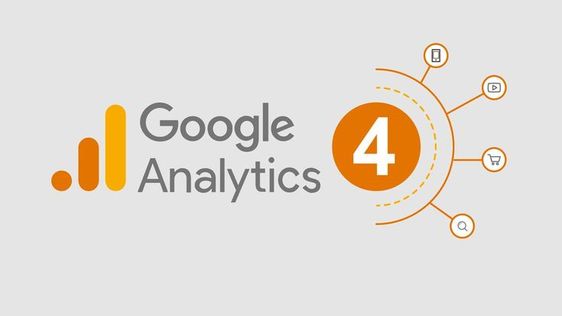Google Analytics 4 (GA4) for E-Commerce is a powerful analytics platform that helps businesses track customer journeys, optimize sales funnels, and improve overall performance. With event-based tracking and AI-powered insights, GA4 enables e-commerce businesses to make data-driven decisions that enhance conversion rates, marketing ROI, and customer retention.
In this article, we’ll explore how GA4 transforms e-commerce analytics, helping businesses gain deeper insights into user behavior, track product performance, and refine sales strategies. For a comprehensive guide on leveraging GA4 across all digital platforms, check out our Ultimate Guide to Google Analytics 4 your go-to resource for mastering GA4.
Setting up your Google Analytics 4 (GA4) for E-Commerce
The first step in using GA4 for e-commerce is properly setting up your account. Ensure you have enabled e-commerce tracking and that your GA4 account is linked to your e-commerce platform. This will allow GA4 to automatically track important metrics like revenue, conversion rates, and average order value.
Tracking sales funnel metrics
GA4 allows you to track important metrics like the number of visitors to your site, how long they stay on your site, and how they interact with your site. By setting up conversion goals and tracking events like add-to-cart and checkout, you can track the entire sales funnel from start to finish.
Analyzing customer behavior
One of the most powerful features of GA4 is its ability to analyze customer behavior. By tracking user behavior on your website, you can gain insights into what drives purchases and how customers navigate your site. You can also use GA4 to create custom audiences based on specific behaviors, which can help you create targeted marketing campaigns.
Example Event Setting for eCommerce:
Let’s consider a scenario where you want to track screen views for an ecommerce mobile app. Here’s how you can set up the event parameters using the gtag() function:
gtag(‘event’, ‘screen_view’, {
‘app_name’: ‘LoveMyShop’,
‘screen_name’: ‘Collections’
});
In this example, ‘app_name’ and ‘screen_name’ are the event parameter names, while ‘MyMobileApp’ and ‘HomeScreen’ are the corresponding values.
Setting Parameters for Every Event:
In addition to setting parameters for individual events, you can configure the Google tag snippet in your HTML <head> tag to send parameters with every event on your website.
Here’s an example of updating the config command in the Google tag snippet for ‘LoveMyShop’ ecommerce store to include parameters for every event on the page:
gtag(‘event’, ‘purchase’, {
‘transaction_id’: ‘12345’,
‘affiliation’: ‘MyOnlineStore’,
‘value’: 59.99,
‘currency’: ‘USD’,
‘items’: [
{
‘item_id’: ‘SKU123’,
‘item_name’: ‘Product A’,
‘item_category’: ‘Electronics’,
‘item_variant’: ‘Black’,
‘quantity’: 2,
‘price’: 29.99
},
{
‘item_id’: ‘SKU456’,
‘item_name’: ‘Product B’,
‘item_category’: ‘Home & Kitchen’,
‘item_variant’: ‘Red’,
‘quantity’: 1,
‘price’: 19.99
}
]
});
In this example, the event name is ‘purchase’ and the event parameters capture details about the transaction. The parameters include:
- ‘transaction_id’: Unique identifier for the transaction (e.g., order number).
- ‘affiliation’: Name of the store or website where the purchase was made.
- ‘value’: Total value of the purchase.
- ‘currency’: Currency used for the transaction.
- ‘items’: An array containing individual item details within the transaction.
For each item in the ‘items’ array, specific parameters are set:
- ‘item_id’: Unique identifier for the item (e.g., SKU or product code).
- ‘item_name’: Name or title of the item.
- ‘item_category’: Category or product type.
- ‘item_variant’: Optional parameter indicating the variant or specific version of the item.
- ‘quantity’: Number of units purchased.
- ‘price’: Price per unit of the item.
These parameters provide valuable insights into eCommerce transactions, enabling you to analyze purchase behaviour, track revenue, and measure the performance of different products and categories.
Understanding attribution models
Attribution models are a way to determine which marketing channels are driving the most revenue for your e-commerce business. GA4 provides several attribution models that can help you understand which channels are most effective at driving sales. By analyzing these models, you can make data-driven decisions about where to invest your marketing resources.
Using Google Analytics 4 for E-Commerce with Google Ads
If you’re running Google Ads campaigns for your e-commerce business, you can use GA4 to track the performance of those campaigns. By linking your Google Ads account to your GA4 account, you can track important metrics like cost-per-click, click-through rate, and conversion rates. This can help you optimize your campaigns and improve your return on investment.
Conclusion
Google Analytics 4 (GA4) is an essential tool for e-commerce businesses looking to optimize sales performance, enhance customer journeys, and maximize revenue. By properly configuring GA4, tracking key sales funnel metrics, analyzing customer behavior, leveraging attribution models, and integrating GA4 with Google Ads, businesses can gain valuable insights to drive data-backed decisions.
Harnessing GA4’s advanced analytics and predictive insights allows e-commerce brands to refine marketing strategies, improve conversions, and enhance customer retention—ultimately boosting profitability.
Maximize your e-commerce tracking in GA4. Get expert help with our Analytics Configuration and Audit Services to improve data accuracy and conversion insights.
Explore our Indian Ecommerce Market Outlook 2025




0 Comments